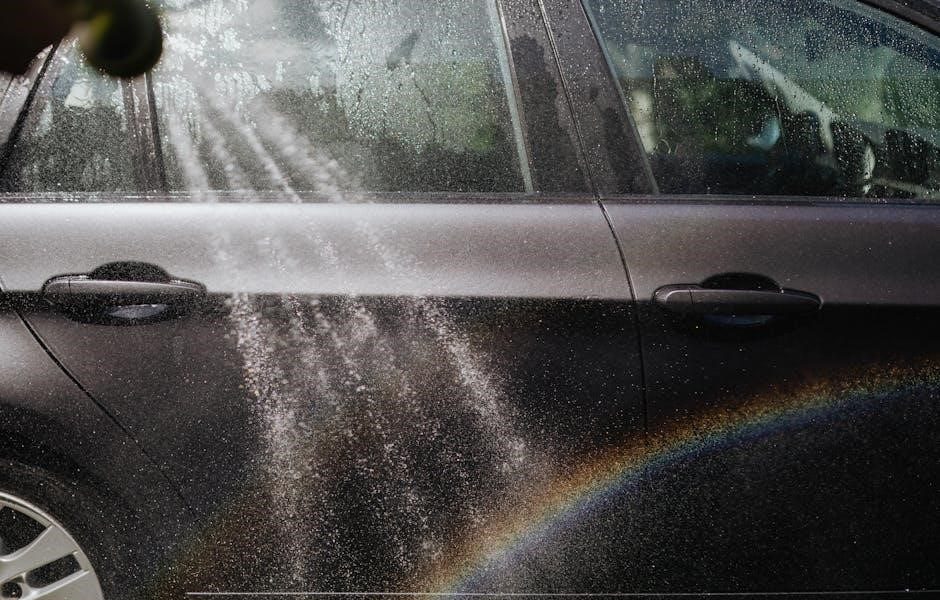
car detailing guide
Car detailing is a meticulous process that enhances and restores a vehicle’s exterior and interior. It involves thorough cleaning, polishing, and protective treatments to maintain the car’s appearance and condition, boosting its resale value and personal satisfaction.
What is Car Detailing?
Car detailing is a comprehensive process that involves meticulously cleaning, restoring, and protecting both the exterior and interior of a vehicle. It goes beyond a simple car wash, focusing on enhancing the car’s appearance, functionality, and longevity. Exterior detailing includes steps like washing, polishing, and applying protective coatings, while interior detailing involves deep cleaning, sanitizing, and conditioning surfaces. Detailing also addresses specific areas such as wheels, tires, and glass. The process aims to restore the car’s original condition, ensuring a showroom-like finish. Whether for personal satisfaction or to maintain resale value, car detailing is a precise and thorough approach to vehicle care.
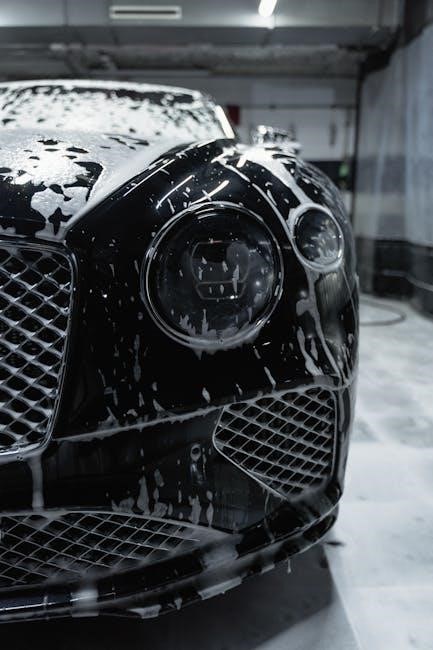
Why is Car Detailing Important?
Car detailing is essential for maintaining the overall condition and longevity of a vehicle. It protects the exterior from environmental damage, such as UV rays, dirt, and contaminants, while preserving the interior from wear and tear. Regular detailing helps prevent paint fade, extends the life of surfaces, and reduces the risk of costly repairs. A clean and well-maintained car also enhances safety by ensuring clear visibility and proper functionality. Additionally, detailing improves hygiene by removing allergens and odors, creating a healthier environment for passengers. It also boosts resale value, as a meticulously maintained vehicle retains its appeal and attracts potential buyers. Ultimately, car detailing combines practicality and aesthetics, offering both functional benefits and personal satisfaction.
Exterior Car Detailing
Exterior detailing focuses on restoring and protecting a car’s outer surfaces. It involves cleaning wheels, washing, paint correction, and applying protective coatings to maintain shine and durability.
Step 1: Wheels and Tires
Start with the wheels and tires, as they are often the dirtiest. Use a wheel cleaner to remove grime and brake dust, then scrub with a brush. Rinse thoroughly and dry with a microfiber cloth. For tires, apply a tire cleaner to remove grease and grime, then rinse and dry. Finally, apply a tire dressing to restore shine and protect the rubber. Avoid using harsh chemicals that can damage the wheels or tires. Regular cleaning and protection help maintain their appearance and longevity. This step is crucial for a detailed exterior finish, ensuring the car looks polished from every angle.
Step 2: Pre-Wash
The pre-wash step is essential for safely removing loose dirt and debris without scratching the paint. Start by rinsing the car thoroughly with water to remove surface dust. Next, apply a snow foam or pre-wash spray evenly across the vehicle, allowing it to dwell for a few minutes to soften stubborn dirt. Use a soft-bristle brush to gently agitate areas like wheels and wheel wells. Rinse the car again to remove the foam and loosened dirt. This step ensures that the contact wash is more effective and reduces the risk of scratches. Avoid using high-pressure washes that could damage sensitive surfaces. Proper pre-washing sets the foundation for a smooth and safe detailing process, ensuring the best results for the next steps.
Step 3: Contact Wash
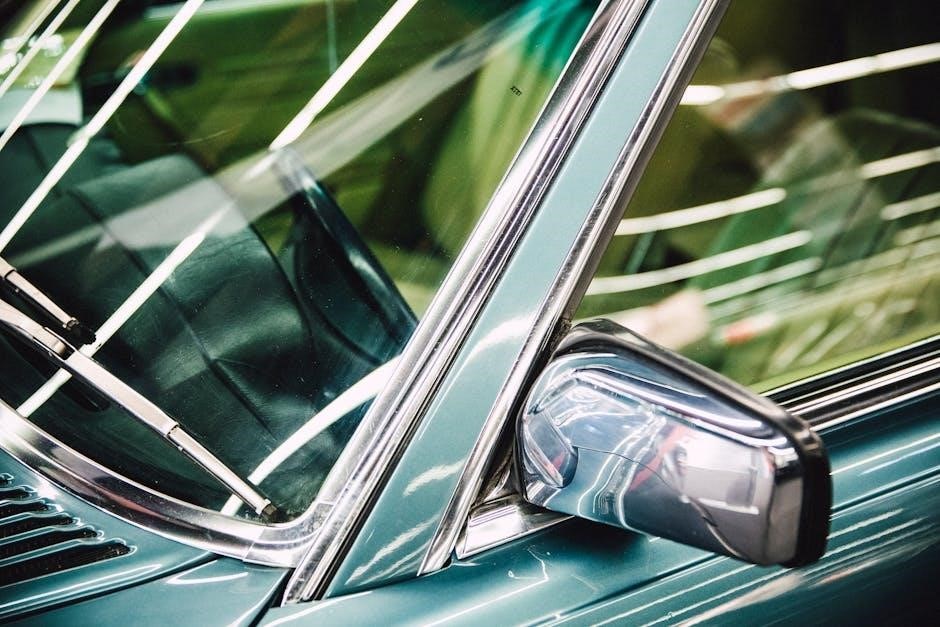
The contact wash is a critical step where you physically remove dirt from the vehicle’s surface. Use the two-bucket method: one for soapy water and another for clean rinse water. Dip a microfiber wash mitt into the soapy bucket, wring it out thoroughly, and gently wipe the car’s surfaces in straight, overlapping strokes. Avoid circular motions, as they can create scratches. Start from the top and work your way down to prevent dirt from redepositing onto clean areas. Regularly rinse the mitt in the clean water bucket to remove loosened debris. This step ensures a thorough removal of dirt without damaging the paint. Proper technique and quality tools are essential for achieving a safe and effective wash. This process lays the groundwork for the next detailing steps, ensuring a smooth and even surface.

Step 4: Paint Enhancement
Paint enhancement is a detailed process aimed at restoring and improving the appearance of the vehicle’s paintwork. This step addresses minor imperfections such as scratches, swirl marks, and oxidation. Techniques like buffing, polishing, and compounding are used to smooth and refine the paint surface. Buffing involves using a rotary or dual-action polisher with specialized pads and compounds to remove defects and enhance gloss. Polishing further refines the paint, creating a mirror-like finish. This step is crucial for reviving dull or damaged paint and preparing the surface for sealing. Proper techniques and tools are essential to avoid over-correction or creating new imperfections. A well-executed paint enhancement not only restores the car’s original shine but also protects the paint from future damage, ensuring long-lasting results.
Step 5: Sealing and Protection
Sealing and protection are the final steps in exterior car detailing, designed to safeguard the vehicle’s surfaces from environmental damage. After washing and paint enhancement, a protective layer is applied to the paint, wheels, and trim. Products like wax, sealants, or ceramic coatings are used to create a barrier against UV rays, water spots, and contaminants. This step ensures long-term protection and maintains the vehicle’s glossy finish. Additionally, protective sprays or dressings are applied to plastics, rubber, and chrome to restore their appearance and shield them from degradation. Regular sealing helps maintain the car’s condition and makes future cleaning easier. This step is essential for preserving the vehicle’s exterior and preventing premature wear and tear from daily exposure to the elements.
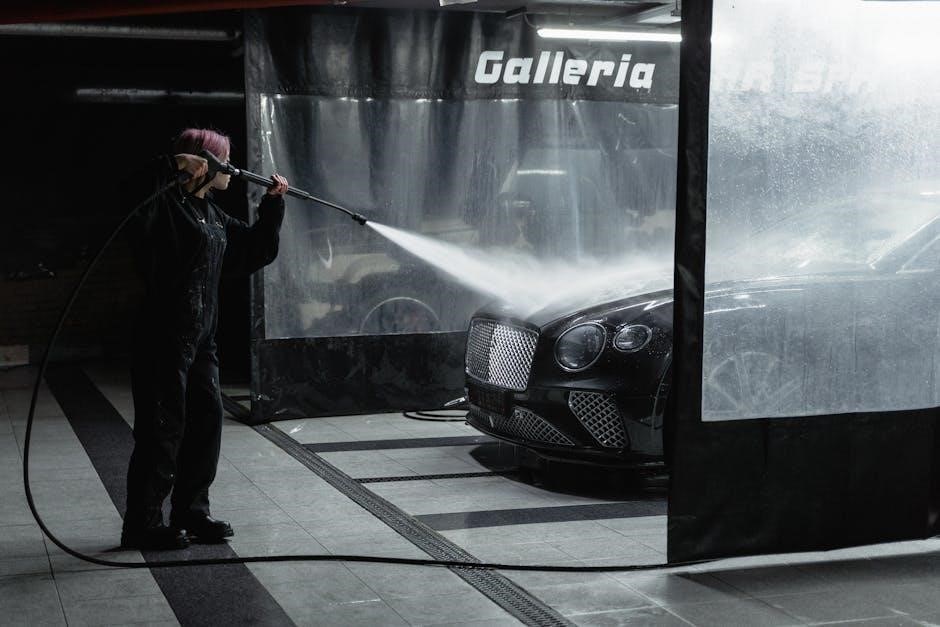
Interior Car Detailing
Interior car detailing focuses on enhancing the cleanliness, comfort, and appearance of the vehicle’s inside. It involves deep cleaning upholstery, dashboards, carpets, and surfaces, ensuring a fresh, hygienic environment while preserving the materials’ longevity and aesthetics.
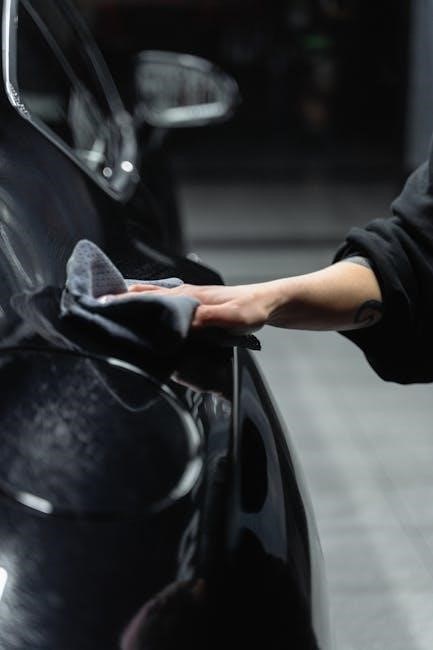
Step 1: Decluttering and Vacuuming
Begin interior detailing by removing trash, personal items, and accessories. Use a small trash bag and gloves for efficiency. Vacuum all surfaces, including seats, carpets, and crevices, using a brush attachment for upholstery. Pay attention to tight spaces like seat gaps and door pockets. For stubborn dirt, gently scrub with a soft-bristle brush before vacuuming. Wipe down surfaces with a damp cloth to remove dust and debris. Organize belongings neatly in the trunk or glove compartment. This step ensures a clean slate for deeper cleaning and sanitizing, preventing dirt and allergens from being spread during subsequent steps. A thorough vacuuming also prepares the interior for advanced cleaning techniques, ensuring a professional finish. Proper decluttering and vacuuming are foundational for achieving superior detailing results.
Step 2: Cleaning Surfaces
After decluttering and vacuuming, focus on cleaning all interior surfaces. Use a high-quality cleaning product suitable for the material, such as leather, vinyl, or fabric. Apply the cleaner to a microfiber cloth, avoiding direct application to surfaces. Gently wipe down the dashboard, center console, and door panels, using light pressure to avoid scratches. Clean high-touch areas like the steering wheel, gearshift, and buttons. For tough stains or spills, let the cleaner sit briefly before wiping. Avoid using harsh chemicals or excessive moisture, which can damage materials; For seats and upholstery, use a damp cloth to remove dirt and stains. Finally, wipe down surfaces with a clean, dry microfiber cloth to remove any residue and ensure a streak-free finish. This step ensures all interior surfaces are clean and ready for further detailing. Proper cleaning prevents damage and enhances the interior’s appearance.
Step 3: Sanitizing and Deodorizing
Sanitizing and deodorizing are essential for a fresh, clean interior. Use a disinfectant spray or wipes to eliminate germs and bacteria, focusing on high-touch areas like the steering wheel, door handles, and gearshift. Allow the product to sit for a few minutes before wiping clean with a microfiber cloth. For deodorizing, apply a neutralizing spray or natural solutions like essential oils to eliminate odors. Avoid harsh chemicals that may damage materials. Pay attention to carpets, upholstery, and the headliner, where odors often linger. Open windows or use fans to ventilate the vehicle, ensuring a pleasant, odor-free environment. This step not only enhances comfort but also maintains the interior’s hygiene and freshness, making it enjoyable for both drivers and passengers. Regular sanitizing and deodorizing are key to preserving your car’s interior health. Always test products on a small area first to ensure compatibility.
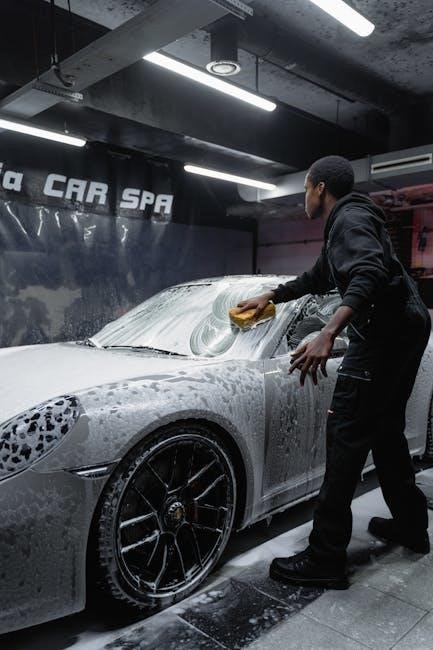
Additional Tips for Better Results
For a flawless detailing experience, consider these expert tips: Always clean in the shade to prevent water spots and soap residue. Use a detail spray for quick touch-ups between washes. Invest in high-quality microfiber towels to avoid scratches. Avoid using household cleaners, as they can damage surfaces. Regular detailing helps maintain the car’s appearance and prevents long-term damage. For tough stains, let cleaning products sit briefly before wiping. Keep the interior dry to prevent mold and odors. Test new products on a small area first. Buffing in circular motions ensures even results. Protect surfaces with coatings or waxes for durability. Stay organized with a detailing kit for efficiency. By following these tips, you’ll achieve professional-like results and keep your car looking its best year-round. Consistency is key to maintaining a pristine vehicle.
Related Posts

national audubon field guide to mushrooms
Unlock the fascinating world of mushrooms! Audubon’s guide makes identification easy & fun. Explore detailed descriptions & stunning photos. Your **mushroom** journey starts here!

being a dik season 2 guide
Dive into the world of “Being a Dik” with our comprehensive Season 2 guide. Get episode breakdowns, key highlights, and insider tips. Your ultimate resource for the latest season!

tv guide delray beach
Discover what’s on TV tonight in Delray Beach. Your complete guide to local channels, shows, and listings. Find your favorite channels now!